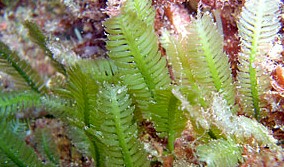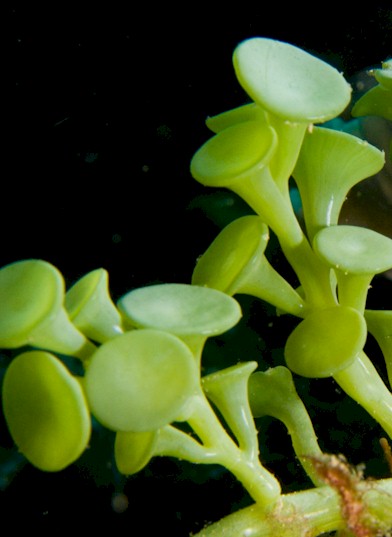|
Species
of Caulerpa belong to the phylum Chlorophyta, which is named for
their dominant green pigment. They are some of the fastest, most
prolific growers, quickly and efficiently removing nutrients from
shallow coastal waters in tropical regions worldwide. In the
marine aquarium there are both advantages and disadvantages to
their use. Generally speaking, if used correctly, various species
of the genus Caulerpa can be both ornamental and utilitarian in
the aquarium. Several species however, due to their adaptability
and the ease with which they can propagate themselves can be a
highly invasive species, especially in reef aquaria. One
such highly invasive species of Caulerpa known as taxifolia was
used in the aquarium trade due to it's hardy growth and attractive
appearance. In June of 2000 the introduced, non native species taxifolia was found in a coastal lagoon in Carlsbad, California,
within San Diego County. An aggressive clone of this species had
already proven to be highly invasive in the Mediterranean Sea,
where the governments of France, Spain, Monaco, and Italy had been
unable to control its spread. This first confirmed American
occurrence of this invasive species in California caused
considerable alarm. The resulting press coverage of the issue led
to discovery of a second infestation of C. taxifolia in Huntington
Harbor located in Orange County. Genetic studies determined that these
two infestations were the same strain threatening the
Mediterranean Sea. To date, the infested areas have been
successfully eradicated, but California has placed restrictions on
its import and use within the state, along with eight other
species of Caulerpa.
 To control the possible
infestation in non
native waters the United States government issued a law making it
illegal to import or transport Caulerpa taxifolia across state
lines including internet sale. California passed stronger
legislation making it illegal to possess, transport, transfer,
release alive, import, or sell Caulerpa. taxifolia,
sertularioides, mexicana, ashmeadii, scalpelliformis, racemosa,
cupressoides, verticillata, and floridana. The city of San Diego took the
ban one step further, banning the possession, sale, and transport
of all Caulerpa species. The two species of commonly
available Caulerpa species that are allowed to hobbyists in California,
are prolifera and serrulata. Although I understand the need to
protect the environment and our fragile coastal ecosystems, it's
unlikely that any of the other eight Caulerpa species banned in
the State of California, if somehow introduced, could survive the
cold Pacific water temperatures. In fact most species of Caulerpa
native to the State of Florida (with the exception of taxifolia
and prolifera) can't survive the cold winter temperatures of
the Atlantic and Gulf of Mexico. In 2024 all Caulerpa
species were banned for sale or distribution in the state of
California. To control the possible
infestation in non
native waters the United States government issued a law making it
illegal to import or transport Caulerpa taxifolia across state
lines including internet sale. California passed stronger
legislation making it illegal to possess, transport, transfer,
release alive, import, or sell Caulerpa. taxifolia,
sertularioides, mexicana, ashmeadii, scalpelliformis, racemosa,
cupressoides, verticillata, and floridana. The city of San Diego took the
ban one step further, banning the possession, sale, and transport
of all Caulerpa species. The two species of commonly
available Caulerpa species that are allowed to hobbyists in California,
are prolifera and serrulata. Although I understand the need to
protect the environment and our fragile coastal ecosystems, it's
unlikely that any of the other eight Caulerpa species banned in
the State of California, if somehow introduced, could survive the
cold Pacific water temperatures. In fact most species of Caulerpa
native to the State of Florida (with the exception of taxifolia
and prolifera) can't survive the cold winter temperatures of
the Atlantic and Gulf of Mexico. In 2024 all Caulerpa
species were banned for sale or distribution in the state of
California.
They're
numerous advantages to including at least some species of Caulerpa
in the marine aquarium. They're not only attractive additions to the aquarium and or the refugium, but they
can provide a food source for fish and invertebrates, as well as
effectively removing excess nutrients. Another benefit is their ability to
stabilize ph levels through photosynthesis. There is also evidence that the
addition of Caulerpa, as well as other varieties of macro algae,
can aid in the reversal of many diseases often present in captive
marine aquarium fish, such as fin rot and lateral line syndrome.
Caulerpa remove the primary nutrients nitrate and phosphate, and
in doing so decrease unwanted nuisance algae of the inorganic
nutrients they need, keeping the growth of pest algae to a
minimum. As the algae increases in size, the aquarist simply trims
and removes any excess growth, permanently removing the
sequestered nutrients from the aquarium’s system. Just like
terrestrial plants, Caulerpa benefit from frequent pruning as the
practice aids in removal of old tissue and encourages new
growth. Hobbyists placing
Caulerpa in a refugium or sump often illuminate the display tank
opposite of the other which helps keep the ph stable during the algae's
respiration or rest period.
 Although
species of Caulerpa can be beneficial, they have a few
downsides. Caulerpa is a very fast grower that can quickly
outgrow its environment and become a nuisance in any aquarium. In
the reef aquarium, Caulerpa can effect corals by covering
them and blocking available light. Some species, such as C.
prolifera are believed to release a chemical that can even stunt
coral growth. This is also true in their natural environment. When
the amount of nutrients on a coral reef get out of balance due to
fertilizer runoff and other pollutants, some opportunistic species
such as C. taxifolia, fueled by excess nutrients, can
quickly take over the ecosystem smothering both native algae and
corals. Another drawback is their resilient ability to spread by
both sexual and asexual reproduction. Vegetative or asexual
reproduction is when the algae forms a new cell from a fragment or
spreads via the rhizome. This can be controlled in most aquariums
by keeping the colony small and containing it to one particular
area. When conditions are favorable Caulerpa will reproduce
sexually, releasing gametes and tissue into the aquarium water.
This phenomena is known as sporualtion and is caused by many
environmental conditions such as a lack of nutrients, temperature,
salinity, ph, etc. These sexual events can be detrimental to both
corals and fish, sometimes releasing large amounts of nutrients and
organic material back into the aquarium water. In the ocean, the
effects are not harmful as the nutrients and tissue are quickly
removed, however in a closed environment such an event can upset
the natural balance in an aquarium if the pollutants can't be
quickly absorbed by the filtration system. In larger, more stable
reef aquariums dead tissue and excess nutrients are normally
cleaned by both the tank inhabitants (live rock, sponges, micro
algae) and or the chemical filtration system (protein
skimmer, filter pads, media, etc) Although
species of Caulerpa can be beneficial, they have a few
downsides. Caulerpa is a very fast grower that can quickly
outgrow its environment and become a nuisance in any aquarium. In
the reef aquarium, Caulerpa can effect corals by covering
them and blocking available light. Some species, such as C.
prolifera are believed to release a chemical that can even stunt
coral growth. This is also true in their natural environment. When
the amount of nutrients on a coral reef get out of balance due to
fertilizer runoff and other pollutants, some opportunistic species
such as C. taxifolia, fueled by excess nutrients, can
quickly take over the ecosystem smothering both native algae and
corals. Another drawback is their resilient ability to spread by
both sexual and asexual reproduction. Vegetative or asexual
reproduction is when the algae forms a new cell from a fragment or
spreads via the rhizome. This can be controlled in most aquariums
by keeping the colony small and containing it to one particular
area. When conditions are favorable Caulerpa will reproduce
sexually, releasing gametes and tissue into the aquarium water.
This phenomena is known as sporualtion and is caused by many
environmental conditions such as a lack of nutrients, temperature,
salinity, ph, etc. These sexual events can be detrimental to both
corals and fish, sometimes releasing large amounts of nutrients and
organic material back into the aquarium water. In the ocean, the
effects are not harmful as the nutrients and tissue are quickly
removed, however in a closed environment such an event can upset
the natural balance in an aquarium if the pollutants can't be
quickly absorbed by the filtration system. In larger, more stable
reef aquariums dead tissue and excess nutrients are normally
cleaned by both the tank inhabitants (live rock, sponges, micro
algae) and or the chemical filtration system (protein
skimmer, filter pads, media, etc)
To
help avoid the conditions that trigger sporualtion in the aquarium
they're a few safeguards. Regular pruning of tissue is required
and will help discourage Caulerpa to reproduce sexually. In
addition to pruning, limiting the size of each cell is important
so that biomass does not exceed the nutrient levels. If growing in
a sump or refugium some hobbyists employ a continuously
illuminated environment so that the Caulerpa can never enter into
the phase of respiration or rest. Although this method does
work to prevent sporulation, it also effects the growth as
respiration is a needed process of photosynthesis. A simpler method
is to simply increase the photoperiod to allow 4-6 hours of rest,
followed by continuous illumination.
|